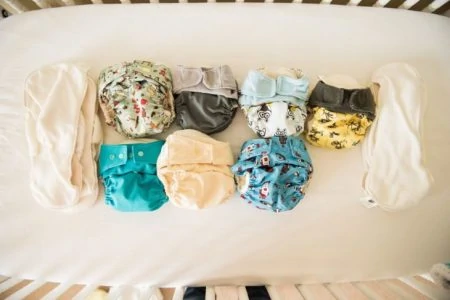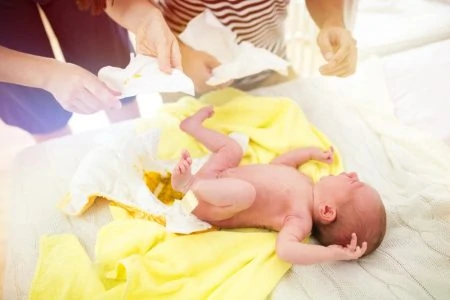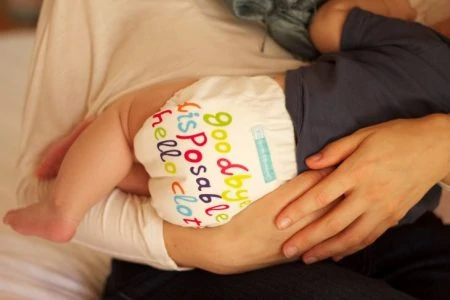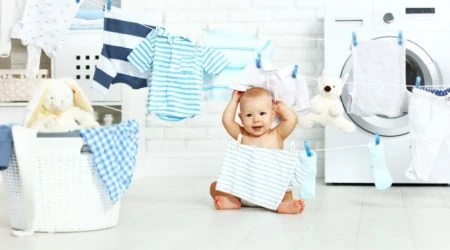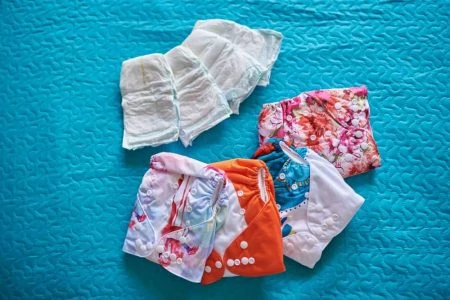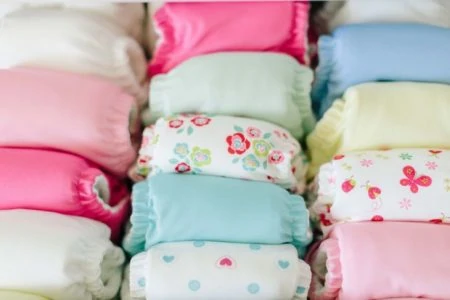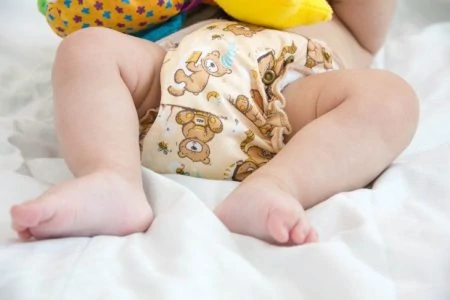Are you ready to quit cloth diapering because of ammonia, yeast, or mold issues?
We have good news! These problems don’t have to mean the death of your cloth diaper journey. Cloth diapers are eco-friendly and cost-effective — it’s worth it to give them a fair shot.
If your diapers are in desperate need of rescue, it’s possible to save them with bleach. Yes, you read that right — good old-fashioned bleach.
The word makes many cloth diaper users cringe, but the truth is, bleach gets a bad rap. We’ve used it to prevent and solve all kinds of cloth diapering issues, and we’ll explain how you can do it too.
Key Takeaways
- Monthly bleach soaks can help break down yeast, ammonia, and prevent detergent buildup in cloth diapers.
- Bleach soaks are necessary for certain situations like used diapers, ammonia, yeast, mold, or maggots.
- Use original liquid bleach that is labeled as a disinfectant for effective disinfection of cloth diapers.
- Bleach soaks should be done with clean diapers in a top-loading washing machine, sink, or bathtub, followed by thorough rinsing and a hot wash with detergent.
Why Routinely Bleach Your Diapers?
Although bleach is often a taboo word in the cloth diaper world, many diaper manufacturers recommend using it once a month to keep your diapers fresh (1).
Bleaching your diapers once a month can help break down yeast and ammonia, eliminate odors, and prevent detergent buildup before they become a larger problem and require tougher measures like stripping.
Many add bleach to their wash cycle, while others choose to do a full-on bleach soak — just to be safe.
Before You Bleach
Why Bleach Your Cloth Diapers?
While routine bleach soaks are a vital part of your cloth diaper routine, certain situations require a bleach soak — planned or otherwise.
1. You’ve Bought Used Diapers
Buying your diapers pre-loved is a great way to stretch your budget further. It can be especially helpful when you’re new to cloth diapering and want to try different diapers to see which work best for your baby.
With used diapers, ensure you do a bleach soak before they ever touch your baby’s bottom.
The previous owner might have used a wash routine that wasn’t adequate or a detergent that irritates your baby’s skin. If their baby had a yeast rash, it could be transferred to your little one.
There’s no way of knowing for sure, so it’s best to do a bleach soak, starting the diapers fresh before you put them on your baby.
2. Ammonia
Ammonia is hard to miss. If you have a problem with it in your diapers, you’ll know almost immediately. The smell will knock you back with an eye-watering fierceness that can make you question using cloth diapers altogether.
The presence of ammonia can be caused by several things, including mineral buildup from hard water, not using enough or using too much detergent, or even your baby wearing a diaper for an extended period.
If you have ammonia in your diapers, you might be tempted to jump straight to stripping them, but that isn’t necessary unless the ammonia smell is caused by hard water. If not, a bleach soak will rid them of the smell.
3. Yeast
If your baby has a rash that lasts longer than one to two days despite keeping them clean, dry, and using rash creams, a yeast rash may be the culprit (2). Yeast can affect any baby, whether they use cloth diapers or disposables.
Other sources might suggest hot washes, OxiClean, or essential oils, but the most effective way to get rid of yeast is a bleach soak (3).
It’s important to bleach your diapers right away if your baby has a yeast rash. This will prevent the spreading or reinfection of yeast.
4. Mold
Mold loves warm and humid environments, so it can occur in many different situations. If you leave a travel wet bag in the car or let diapers sit in the pail too long, mold can begin to grow.
If you ever experience mold on your diapers, you might be tempted to throw them out and start fresh with new diapers, but don’t pull out your wallet just yet. A bleach soak kills the mold and makes your diapers good as new again.
If a bleach soak doesn’t get out the mold stains right away, try a more concentrated bleach soak, or soak the diapers in OxiClean.
5. Maggots
As much as it makes my skin crawl to write this, you can end up with maggots in your cloth diapers if you’re not careful.
If you leave diapers in the diaper pail for too long or don’t remove the waste from a dirty diaper after changes, you’re creating the perfect environment for flies to breed.
Even cringe-worthy maggots don’t mean your diapers are ruined, though! A good wash in hot water and a bleach soak will kill everything, making your diapers good as new again.
Which Bleach Should I Use?
Before we talk about how to bleach your cloth diapers, it’s important to remember that not all bleaches are made equal.
When bleaching your cloth diapers, it’s important to choose the original liquid bleach. It should say on the label that it’s a disinfectant.
Splashless bleach varieties will not disinfect your diapers and will cause you to have to repeat the process all over again.
Where Should I Use Bleach?
Start Clean
Your monthly bleaching doesn’t have to be a full-on soak. You can sanitize your diapers once a month by simply adding a quarter cup of chlorine bleach to your warm wash routine. Be sure to rinse your diapers thoroughly after the wash.
An extra rinse is always a good idea — bleach can sometimes irritate a baby’s delicate skin, so make sure to rinse the diapers well!
Editor's Note:
Mary Sweeney, BSN, RN, CENBleaching With a Washing Machine
If you’re having an emergency situation such as mold or yeast, or you want to ensure your diapers get a little extra TLC during your monthly bleach treatment, a bleach soak is the answer.
If you have a top-loading washing machine, this is your easiest bleaching option.
Follow these steps to do a bleach soak in a top-loading washing machine.
- Fill the washer: Fill your washer with cold water.
- Add the bleach: Add the following amount of bleach, depending on the size of your washer. If your tub is small, use one-third of a cup of bleach. For a medium washing machine, add half a cup of bleach. For a large washing machine, use three-quarters of a cup of bleach.
- Soak the diapers: Allow the diapers to soak for at least 30 minutes, but do not exceed 45 minutes.
- Rinse the diapers: Once the diapers are done soaking, rinse them with hot water, then follow with a hot wash. Make sure to use detergent in the hot wash to fully break down the bleach.
Laundry Tip
Soaking in a Sink or Bathtub
If you don’t have a top-loading washer, you can still bleach soak your diapers. Use a sink or a large bucket for small loads of diapers or a bathtub for larger loads.
You’ll use the same general routine for soaking your diapers in a sink or bathtub as for soaking in a top-load washing machine. Soak the diapers in cold water with bleach added. Rinse out the diapers with hot water, and follow with a hot wash in a washing machine with detergent.
The only thing that changes is the amount of bleach you add:
- For a half-full bathtub: Add half a cup of bleach.
- For a full bathtub: Add one cup of bleach.
- For a sink or bucket: Add one tablespoon per gallon of cold water.
Hard Water and Bleach Soaks
Bleach soaks are a great way to sanitize your cloth diapers, but if you have hard water, you need to avoid doing chlorine bleach soaks altogether.
Chlorine can react with the iron that has dissolved in your hard water and cause stains (4).
Instead of using chlorine bleach with your hard water, use Borax and peroxide.
For a half-full bathtub of cold water, add four cups of peroxide and one cup of Borax. Rinse in hot water, then follow with a hot wash that has detergent added.

